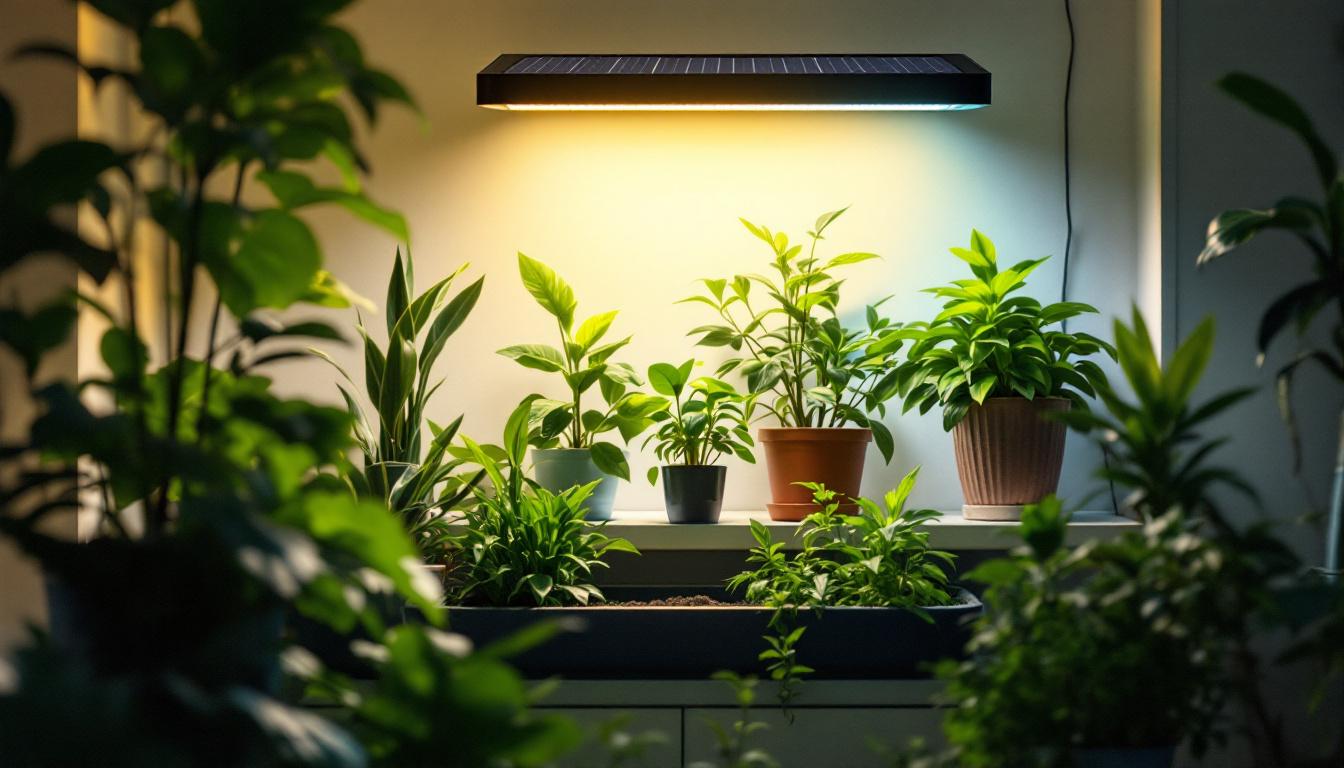
As the demand for sustainable and energy-efficient lighting solutions grows, solar powered plant lights have become a significant innovation in the lighting industry. For lighting contractors, understanding the technology, applications, and installation considerations of these lights is essential to meet client expectations and regulatory standards. Solar powered plant lights combine the benefits of renewable energy with horticultural lighting, offering an eco-friendly alternative to traditional electric plant lights.
These lights harness solar energy during the day and use it to power LED grow lights at night or in low-light conditions, promoting healthy plant growth without increasing electricity costs. This technology is particularly relevant for outdoor landscaping, urban farming, greenhouses, and even indoor plant installations where wiring or electrical access is challenging.
One of the standout features of solar powered plant lights is their ability to operate autonomously, making them ideal for remote locations where conventional power sources are not feasible. By incorporating advanced solar panel technology and energy storage solutions, these lights can efficiently capture and store sunlight, ensuring that plants receive the necessary light even during cloudy days or at night. This capability not only supports plant health but also contributes to the overall resilience of urban green spaces, allowing for more diverse plant life in areas that may otherwise struggle to thrive.
Moreover, the versatility of solar powered plant lights extends beyond just functionality; they also come in a variety of designs and styles to suit different aesthetic preferences and landscaping needs. From sleek, modern fixtures to more rustic designs, these lights can be seamlessly integrated into any garden or outdoor space. Additionally, many models are equipped with smart technology features, such as motion sensors and timers, enabling users to customize lighting schedules based on specific plant requirements or seasonal changes. This adaptability makes solar powered plant lights not only a practical choice but also a stylish one, enhancing the beauty of outdoor environments while promoting sustainability.
At the core of every solar powered plant light is a photovoltaic (PV) solar panel that converts sunlight into electrical energy. The efficiency of these panels directly impacts the light’s performance. Modern solar panels used in plant lights typically employ monocrystalline or polycrystalline silicon cells, with monocrystalline panels offering higher efficiency and better performance in low-light conditions.
Lighting contractors should evaluate panel size, wattage, and placement to ensure optimal energy harvesting. Proper orientation and tilt angle are critical to maximize sunlight exposure, especially in regions with variable weather or shading from surrounding structures or vegetation. Additionally, advancements in solar technology have led to the development of bifacial solar panels, which can capture sunlight from both sides, further enhancing energy collection. This innovation is particularly beneficial in urban environments where reflected light can be harnessed from nearby surfaces, making solar powered plant lights even more efficient.
Solar powered plant lights rely on rechargeable batteries to store energy collected during daylight hours. Lithium-ion batteries are the preferred choice due to their high energy density, longer lifespan, and lightweight design compared to traditional lead-acid batteries.
Effective power management systems regulate charging and discharging cycles, protecting battery health and ensuring consistent lighting output. Contractors should be aware of battery capacity ratings, charge controller types, and expected battery life to recommend systems that align with client needs and maintenance capabilities. Moreover, some systems now incorporate smart technology, allowing for remote monitoring and management of battery levels and light output. This feature not only enhances user convenience but also enables proactive maintenance, ensuring that the plant lights operate at peak efficiency throughout their lifespan.
Light Emitting Diodes (LEDs) are the most common light source in solar powered plant lights due to their energy efficiency and customizable spectral output. Different plant species require specific light spectra for optimal photosynthesis, typically in the blue (400-500 nm) and red (600-700 nm) wavelengths.
Advanced solar powered plant lights feature adjustable or full-spectrum LEDs that can cater to various growth stages, from seedling to flowering. Lighting contractors should understand the spectral requirements of the plants being cultivated to select or recommend the appropriate lighting system. Furthermore, the integration of smart technology in LED systems allows for automated adjustments based on real-time environmental conditions, such as temperature and humidity. This adaptability not only promotes healthier plant growth but also conserves energy by ensuring that lights operate only when necessary, further enhancing the sustainability of solar powered plant lighting solutions.
Solar powered plant lights are ideal for enhancing outdoor landscapes, parks, and urban green spaces where electrical infrastructure may be limited or costly to install. These lights provide both aesthetic illumination and functional plant growth support, contributing to healthier vegetation and visually appealing environments.
For lighting contractors, offering solar powered solutions can differentiate services by promoting sustainability and reducing client energy expenses. Additionally, these systems often qualify for green building incentives or rebates, adding value to project proposals.
In greenhouses and indoor farms, supplemental lighting is crucial for optimizing plant growth cycles. Solar powered plant lights can reduce dependence on grid electricity, especially in remote or off-grid locations. When integrated with energy management systems, these lights can contribute to lower operational costs and improved environmental footprints.
Contractors working in agricultural lighting should consider the scalability and integration capabilities of solar powered plant lights with existing infrastructure, ensuring seamless operation and maintenance.
Indoor plant enthusiasts and commercial spaces such as offices and retail stores increasingly seek sustainable lighting options to support indoor greenery. Solar powered plant lights, often combined with window-facing solar panels or portable solar units, offer a flexible solution without the need for complex wiring.
Lighting contractors can capitalize on this trend by advising clients on suitable solar powered lighting setups that enhance indoor air quality and aesthetics while minimizing energy consumption.
Before installation, a thorough site assessment is crucial to determine solar access and potential shading issues. Lighting contractors should analyze sun path, nearby obstructions, and seasonal variations to position solar panels optimally.
Utilizing tools such as solar pathfinders or digital modeling software can improve accuracy in predicting solar exposure, which directly affects system performance and client satisfaction.
Solar powered plant lights typically require minimal wiring, but proper mounting of solar panels and light fixtures is essential for durability and efficiency. Panels should be securely mounted on rooftops, poles, or ground mounts with adjustable brackets to optimize angle adjustments over time.
Contractors should also ensure weatherproofing of all electrical connections and use corrosion-resistant materials to enhance longevity, especially in outdoor or humid environments.
While solar powered plant lights are generally low-maintenance, periodic cleaning of solar panels to remove dust, debris, or snow is necessary to maintain optimal energy absorption. Battery health should be monitored, with replacements planned based on manufacturer recommendations and usage patterns.
Contractors should educate clients on simple maintenance routines and provide troubleshooting support for common issues such as dimming lights, battery failures, or sensor malfunctions.
One of the primary challenges with solar powered plant lights is their reliance on consistent sunlight. Extended periods of cloud cover or shading can reduce energy harvesting, potentially limiting light output during critical growth phases.
Battery capacity and quality become vital in mitigating these effects, but contractors must set realistic expectations with clients regarding performance variability in different climates.
Although solar powered plant lights can reduce long-term energy expenses, the upfront cost of high-quality solar panels, batteries, and LED fixtures can be higher than conventional lighting systems. Lighting contractors should provide comprehensive cost-benefit analyses, factoring in energy savings, maintenance costs, and potential incentives to help clients make informed decisions.
Integrating solar powered plant lights with existing electrical or automation systems may require specialized knowledge and equipment. Contractors should stay updated on the latest standards, communication protocols, and compatibility issues to ensure smooth system integration and future scalability.
Ongoing research in photovoltaic technology promises higher efficiency solar panels that can capture more energy in smaller footprints. Emerging materials like perovskite solar cells and bifacial panels are expected to enhance performance, particularly in low-light or diffuse sunlight conditions.
Lighting contractors should monitor these developments to offer cutting-edge solutions that maximize energy harvesting and reduce installation space.
Smart lighting controls integrated with Internet of Things (IoT) technology enable remote monitoring, automated scheduling, and adaptive lighting based on plant growth stages or environmental conditions. These features improve energy management and plant health outcomes.
Contractors who embrace smart solar powered plant lighting systems can provide clients with enhanced control and data-driven insights, adding value and competitive advantage.
Hybrid lighting systems combining solar power with other renewable sources or grid electricity offer increased reliability and flexibility. Additionally, advancements in energy storage, such as solid-state batteries and supercapacitors, promise longer life cycles and faster charging times.
Understanding these innovations will help lighting contractors design resilient systems tailored to diverse project requirements.
Solar powered plant lights represent a transformative opportunity for lighting contractors to deliver sustainable, efficient, and innovative lighting solutions. By mastering the technology, applications, and installation best practices, contractors can meet the evolving demands of clients seeking green alternatives in landscaping, agriculture, and indoor environments.
While challenges such as weather dependency and initial costs exist, ongoing advancements in solar technology, smart controls, and energy storage are steadily enhancing the viability and appeal of solar powered plant lighting. Staying informed and adaptable will enable lighting contractors to lead in this growing market segment and contribute meaningfully to global sustainability efforts.
Ready to elevate your lighting projects with sustainable, efficient solutions? LumenWholesale is here to support your journey with solar powered plant lights that blend innovation with affordability. Our spec-grade lighting products are designed to meet the highest industry standards, ensuring you deliver exceptional value to your clients. Say goodbye to inflated markups and hello to premium lighting at wholesale prices, complete with the convenience of free shipping. Don’t compromise on quality or cost. Discover the best value in wholesale lighting and make your next project shine with LumenWholesale.

Discover how stair lighting indoors is transforming spaces and offering a competitive edge for lighting contractors.

Discover the ultimate guide for lighting professionals with our comprehensive checklist on outdoor motion sensor lights.

Discover the essentials of architectural square linear lights in this insightful guide tailored for lighting contractors.

Discover the essential guide for lighting contractors on tanning bed bulbs.